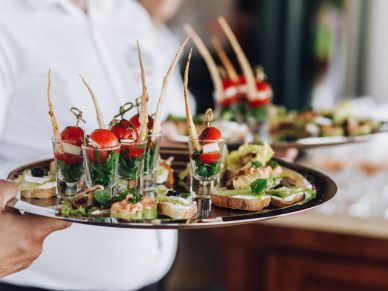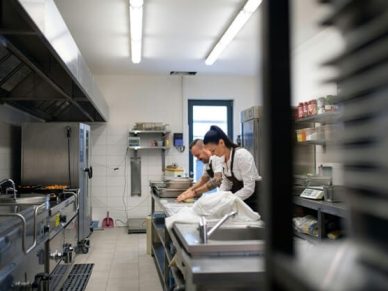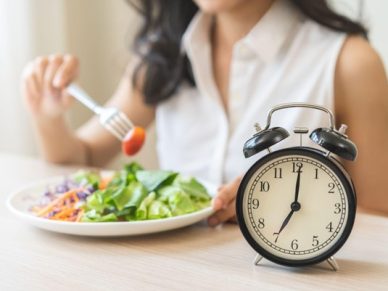Find out how food and beverage trends will change your life this year.
You may not be dusting turmeric in your pea milk or fetching rich dark chocolate with a touch of cannabidiol yet, but this writer certainly reaches for Kombucha more often than ever before. Drinkable collagen is still on my must-try list—jet black lemonade hangover cure, anyone?
If you’ve noticed kimchi and bone broth popping up at your local markets, 2016 was largely motivated by taste AND nutrition.
“Being healthy-ish is a lot more fun than being healthy,” explained Bon Appetit Deputy Editor Andrew Knowlton. “Like the brassicas family—you had kale, you had Brussels sprouts—all the stuff that none of us wanted to eat as kids is coming back.”
Activated charcoal, cauliflower, seaweed, nutritional yeast, and adaptogens—derived from mushrooms, herbs, or plants, which are promoted for ridding the body of stress—are just a sampling of the healthy-ish trends that brought hippie culture and natural foods into the mainstream.
These previous trends and new innovations in 2017 will unlock even more unexpected edibles in our grocery aisles. Look ahead to see what the old world, plant power, and mindfulness will bring to food and drink trends to change your life in the year ahead.
Touchstones of Global Trends
According to Mintel’s 2017 Global Food and Drink Trends report from 60 global analysts, there are six key food and beverage trends to anticipate in the coming year. Mintel’s forecast offers an in-depth glimpse of the future food and beverage landscape with the changes underfoot across Europe, North America, North Asia, Australia, and New Zealand.
However, the report presents new opportunities in the aforementioned regions as well as in Latin America, the Middle East, Africa, and South Asia, according to Global Food and Drink Analyst, Jenny Zegler.
Return to the Ancient World: In Tradition We Trust
What better time to have modern amenities combined wit h age-old traditions?
h age-old traditions?
“The trust in the familiar does not eliminate the need for innov
ation; instead, it [emphasizes] the opportunity for manufacturers to look to the past as a dependable source of inspiration,” Mintel explained.
An example? Take Paper Boat’s success in India. The beverage company offers traditional regional recipes—mango-based aam panna—in slick grab-and-go packaging. It isn’t any surprise that shoppers seek authentic connections in their food and drink, especially in this volatile world.
A wide-ranging quest for authenticity and the narrative behind our food and drink products has taken craft, artisanal, and handmade items to a whole new level over the past several years.
Retro-inspired products have also experienced a boost from this longing for “tangible connections with the past that lend an element of trustworthiness to the claims or tales told by the product.” Mintel suggests that this move to the past will lead to further innovations that use the familiar as a basis for “something that’s new, but recognizable.”
This concept of “accessible innovations” not only lowers the risk of investment by consumers—across all income levels—but leverages already beloved formulations, flavors, and formats.
“In the future, more products will specifically link with the past in order to encourage trust among consumers,” Mintel pointed out.
This includes going way back in time: according to the Mintel Global New Products Database (GNPD), there was a 269 percent increase in global food and drink launches describing their products as “ancient” between September 2010-August 2011 and September 2015-August 2016.”
Such “ancient” items include ancient grains, but they also tap into the potential of ancient recipes, practices, and traditions. Plant Power: Natural Diet Preferences
Plant Power: Natural Diet Preferences
Take a scroll through Instagram and you’ll find healthy eats, clean living, and fitness are all in vogue.
Consumers are making fruits, veggies, nuts, seeds, grains, and botanicals priorities. Manufacturers are answering the call to these food and beverage trends with plant-forward solutions.
In 2016, plants won top billing in product names and marketing. Evian launched a line of flavored water with Evian Fruits & Plants, featuring combinations like lemon juice with elderflower.
Meanwhile U.S. non-dairy milk brand Silk kicked off the “Do Plants” campaign featuring Venus Williams, Jimmy Fallon, and DJ Khaled.
“The emphasis on plant content reinforces the growing interest in vegetarian and vegan products, many of which are chosen by consumers for an occasional drink, snack or meal rather than as part of a wholesale change to a plant-based lifestyle,” Mintel pointed out.
The mainstream appeal of vegetarian and vegan products—those intentionally free from animal products—is a large part of “flexitarian” lifestyles integrating more and more plant-based goods. Plants add limelight as inherent nutrient-rich additions to food and beverages, which help brands connect with shoppers’ renewed interest in health and wellness.
Plants are no longer a garnish or an afterthought. Soon, with the help of technology, they will jump from the closing credits to a leading role in your grocery experience.
Zeroing in on Sustainability: Waste Not
According to the Food and Agriculture Organization of the United Nations, nearly one third—that’s just over 1.4 billion tons—of food produced for human consumption worldwide is lost or wasted. In the U.S. alone 133 billion pounds of food are wasted each year. $31 billion worth of food is wasted in Canada annually, which adds up to 40 percent of all Canadian food produced each year.
“Consumer awareness of the issue of food waste is also spreading because of efforts by retailers and restaurants to reduce or donate food and drink that is past the sell-by date, blemished or damaged,” Mintel’s report said.
One of the first to rally awareness about the issue was French grocery Intermarché. Its high fashion ad campaigns showcased misshapen fruit and vegetables underscored with phrases like “An ugly carrot is a beautiful soup”. This helped kick off the 2015 introduction of a limited edition line of cakes and biscuits with visual defects—defects that would have normally excluded them from store shelves.
Momentum from raised awareness has eased retailers and restaurants to follow suit in recent years by pledging to reduce or donate food and beverages that are normally thrown out. Whole Foods and Walmart are both testing the sales of imperfect products.
 In the U.K., Snact has even concocted a 100 percent fruit s
In the U.K., Snact has even concocted a 100 percent fruit s
nack made of “ugly” fruit that would have otherwise been tossed.
Outlook on food waste offers a rare moment to innovate. With attention on the previously discarded, including food and beverage manufacturing byproducts, an important lesson is emerging: not all waste has to be edible in order to be useful.
“Production waste can have an advantageous afterlife as compost, material for plant-based packaging, or power sources for hospitals and homes… In the future the advantages presented by food waste will lead to a wealth of solutions across a range of industries,” the 2017 Mintel report explained.
Convenience, Convenience, Convenience
30 percent of Canadian breakfast eaters say that breakfast products that require little or no preparation are important to them. According to GNPD, the number of global food and drink launches with on-the-go claims increased 54 percent between September 2010-August 2011 and September 2015-August 2016.
Fast food is not the goal here, it’s balance. Slow foods—slow-roasted goods and items boasting slow-release energy, for example—experienced a 214 percent growth in launches between September 2010-August 2011 and September 2015-August 2016. Would you chew your latte if it afforded you more time? It may feel like astronaut food because it is: two gummy cold-brew coffee Go Cubes claim to offer the same amount of caffeine as a cup of joe.
Would you chew your latte if it afforded you more time? It may feel like astronaut food because it is: two gummy cold-brew coffee Go Cubes claim to offer the same amount of caffeine as a cup of joe.
For those with even loftier efficiency goals, biohacked food and drink has enabled brands like Soylent in the U.S. and Huel in the U.K. to replace entire meals with nutrient complete beverages.
These items add value by saving time, but consumers may want to save time at some occasions and spend some time during others.
“The focus on time when it comes to cooking has led to growth in a myriad of shortcuts, including extended-shelf-life herb purees, quick-cooking sides, and home delivery services,” the Mintel report explained.
Many of these timesaving solutions allow consumers to bypass one portion of the meal-making process without sacrificing key elements such as nutrition or [personalization].”
In 2017, food and beverage trends will demand that more products display details on efficiency. Fresh produce delivery in less than an hour? Unplis has you covered in Barcelona. South Korea’s Maeil Bio saves you days of work with its yogurt which is fermented for eight hours and aged for 24 hours.
In Singapore, Nespresso’s Prodigio smart coffee machine owners can even begin brewing and receive mobile notifications when their coffee is ready. What’s next? Late Night Eats: The Evening Hours
Late Night Eats: The Evening Hours
Sleep better. Wake refreshed. Balance your body. Sound familiar?
The gig economy and the 24-hour workforce are driving the demand for the modern meal at all hours—and for calming nighttime nourishment to aid sleep. Just as therapeutic coloring books have flown off shelves in recent years, consumers are now seeking functional fare that acts as overnight remedies for the pressures of modern living.
One perfect example of this trend is Kellogg’s night-focused All-Bran cereal in Mexico and Columbia. It not only acts as a revitalizing force before bedtime with nutritional properties that aid digestion, but comes in a box designed as a night sky.
“More products can leverage the reputation of the tea category and use chamomile, lavender, and other herbs in formations as a way to achieve a sense of calm before bedtime,” Mintel suggested.
Nighttime meal innovations also include relaxing ingredients like melatonin, lavender, and late night snacks like NightFood, which seeks to curb hunger after dinner while supporting better sleep.
 Nightfood founder Sean Folkson told Food Navigator that the bars incorporate “sleep-friendly” ingredients, including sleep aids magnesium and calcium, a cocoa-based ingredient called Chocamine to promote “satiety”, and five grams of fiber and slow-digesting carbs to strategically leave snackers satiated overnight—but totaling only 140 calories.
Nightfood founder Sean Folkson told Food Navigator that the bars incorporate “sleep-friendly” ingredients, including sleep aids magnesium and calcium, a cocoa-based ingredient called Chocamine to promote “satiety”, and five grams of fiber and slow-digesting carbs to strategically leave snackers satiated overnight—but totaling only 140 calories.
Gatorade is soon introducing an addition to the pre-bedtime routine product lineup and its nighttime yogurt snack—designed to help athletes recover while they sleep—is in the works.
In the U.S., 56 percent of women and 46 percent of men claim that stress is a health issue that concerns them. Relaxation is a commodity that is in demand worldwide, and consumption patterns point towards more products positioned to be nighttime bites, wind-down noshes, and bedtime beverages.
Affordable Health Food: Balancing the Scales
According to the World Bank, 638.3 million people around the world are considered to be low-income.
“For lower-income consumers, access to, and the affordability of, food and drink are genuine concerns, especially because many lower-income people are at risk for food-related health issues, such as obesity and diabetes,” Mintel reported.
“While low household income does not directly cause these health issues, lower income populations are more susceptible because of their lack of access to fresh food, limited time to dedicate to physical activity and high levels of stress or anxiety.”
But cheaper “economy” food and beverages are on the rise thanks to demand for better value when it comes to natural, organic, or other healthy items from all income levels.
Shoppers are shaping the affordability of a healthy lifestyle simply by striving to improve their lives, especially lower-income consumers.
Take the U.S. for example. 42 percent of adults who purchase vegetables and have a household income that’s under $25,000 a year are actively endeavoring to include more veggies in their diet… but only 27 percent of U.S. adults with a low household income are buying more vegetables this year compared with last year.
Part of the solution lies in food waste, another in paying it forward.
2017 and Beyond
Yes, when looking forward, we must look back. Simplicity, nostalgia, and convenience will take 2017 by storm.
FoodBev Media predicts that the spotlight on sustainability and simplicity in food packaging will burn bright, along with “crafty nostalgia” in artisanal food—not just craft beer—convenience, grab-and-go, personalization, and specialty spirits.
When it comes to sustainability, consumers—especially those in their 20s and 30s—are now more focused than ever on what they eat.
However, CEO of Hampton Creek Josh Tetrick pointed out, “We want to use less carbon and create products that are better for animals. But we don’t necessarily need the mom who buys it to know it. We just need it to be affordable and taste good.”
Disputes over GMOs will continue, and now that Vermont passed a labeling law, 2017 will bring the New England state to center stage for other constituents and countries eager to enter the arena.
Consumers also want to know how many resources are at stake and wasted in food production. This trend is no longer a niche issue, and the E.U. and U.S. have launched goals to cut waste in the future. Technology is an essential element in making food more sustainable, affordable, and steadily available—three ingredients for living a more inspired global epicurean lifestyle.















